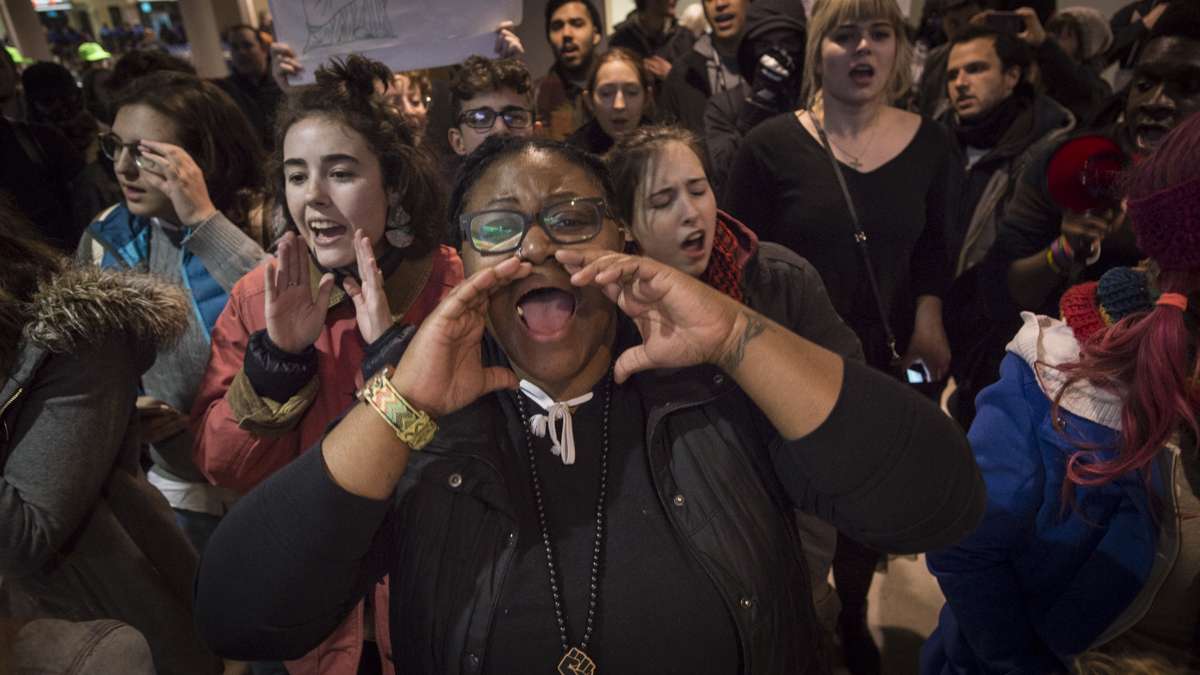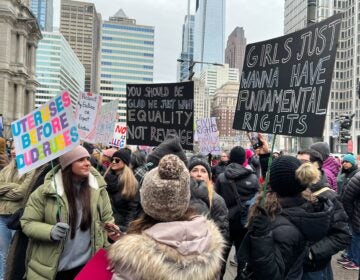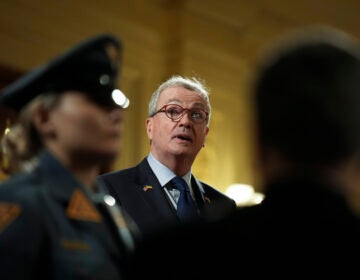Huge protests of ’17 lead to individual activism, expectations of bigger rallies
The protests were fast and furious once Donald Trump became president. Some say that momentum has slowed considerably, while others forecast larger demonstrations.
Listen 3:39
Protesters chant slogans inside the terminal at Philadelphia International Airport. (Branden Eastwood for WHYY)
Nine days after Donald Trump was sworn in as president, thousands of demonstrators clogged Philadelphia International Airport to protest Trump’s first travel ban. The mass showing came a day after word spread that a Syrian family of six with green cards was detained there and then sent back to the Middle East.
Blanca Pacheco helped organize the demonstration with the New Sanctuary Movement, an interfaith immigrant rights group. She learned something following the huge airport turnout a year ago.
“After protests, if people don’t have a role to play in the movement, then it just dies there,” she said.
Pacheco said her group had trouble getting some of those who carried signs and protested at the airport to show up for more grass-roots, lower-profile organizing.
And while Pacheco has found that big protests do not necessarily fuel continuing social activism, other organizers believe movements such as #MeToo will keep propelling demonstrations against presidential policy in 2018.
Even though interest in New Sanctuary Movement has grown since Trump came into office, Pacheco has been encouraging people to focus more on personalized immigration work — rather than going to a protest and treating it as a one-and-done.
“Like doing some voter engagement,” Pacheco said. “Educate and develop new organizers who will be able to stand up.”
Others, though, are still concentrating on headline-grabbing protests — such as last year’s massive Women’s March on Washington.
More than 50,000 demonstrators took part in Philadelphia’s Women’s March, and the second Philadelphia march planned for Saturday is expected to be even bigger, with up to 60,000 protesters.
Organizer Emily Cooper Morse said growing attention to sexual harassment and the controversial U.S. Senate candidacy of accused child molester Roy Moore in Alabama have reignited interest in the march.
“Between the Harvey Weinstein expose and the MeToo hashtag, that really regalvinized some emotions in a lot of us,” Cooper Morse said. “Also, the election in Alabama.”
On top of planning the women’s march, which she said has essentially functioned as a second full-time job, Cooper Morse has been helping more women become politically involved in other ways.
“There are forms of resistance that aren’t measured by large staged protests,” she said. “There are people that are more involved with their Democratic committees. There are people running for office in record numbers.”
Taking an elective path
Also keeping a close eye on the Trump administration this year is Philadelphian Henry Sias, co-chair of the Liberty City LGBT Democratic Club.
The major protests of 2017 have helped create alliances, he said.
“A lot of people met at those protests and grew to know each others’ concerns at those protests and learned how much they have in common,” he said. “Even though, ostensibly, they were working in different ways and different directions with different priorities.”
Sias ran an unsuccessful campaign in Philadelphia to become one of the nation’s first transgender judges. Defeat aside, he said he is not giving up.
“People should run for office,” Sias said. “Find a way to get involved. That would be the main lesson I’ve learned in the past year. Because we can’t do this as a spectator sport. Everybody has to pitch in.”
Cooper Morse acknowledged that many activists have talked to her about what she calls “resistance fatigue.”
It feels impossible to fight back against every drib and drab of the Trump presidency, she said, and it’s easy to feel defeated.
Saturday’s demonstration may provide a jolt of new energy.
“I think that 2018 is the year of women,” Cooper Morse said. “I think that the Women’s March of 2017 was just the beginning, the genesis of the next version of a true women’s movement.”
WHYY is your source for fact-based, in-depth journalism and information. As a nonprofit organization, we rely on financial support from readers like you. Please give today.




